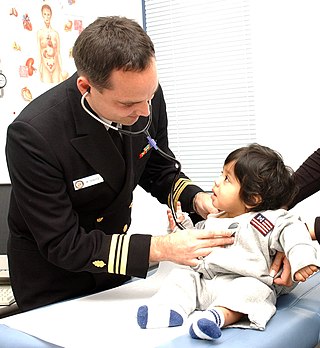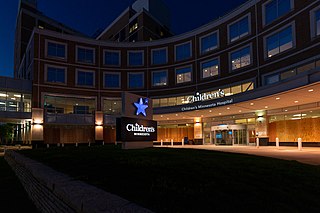Related Research Articles
The Bachelor of Science in Nursing also known in some countries as a Bachelor of Nursing (BN) or Bachelor of Science (BS) with a Major in Nursing is an academic degree in the science and principles of nursing, granted by an accredited tertiary education provider. The course of study is typically three or four years. The difference in degree designation may relate to the amount of basic science courses required as part of the degree, with BScN and BSN degree curriculums requiring completion of more courses on math and natural sciences that are more typical of BSc degrees and BN curriculums more focused on nursing theory, nursing process, and teaching versions of general science topics that are adapted to be more specific and relevant to nursing practice. Nursing school students are generally required to take courses in social and behavioral sciences and liberal arts, including nutrition, anatomy, chemistry, mathematics, and English. In addition to those courses, experience in physical and social sciences, communication, leadership, and critical thinking is required for a bachelor's degree. BSN programs typically last 2–4 years. Someone who holds a BSN can work in private or public medical and surgical hospitals, physician's offices, home health care services, and nursing facilities. Having a BSN can result in more opportunities and better salary than just an associate degree.

A nurse practitioner (NP) is an advanced practice registered nurse (APRN) and a type of mid-level practitioner. NPs are trained to assess patient needs, order and interpret diagnostic and laboratory tests, diagnose disease, formulate and prescribe medications and treatment plans. NP training covers basic disease prevention, coordination of care, and health promotion. One study found that although reasons for referrals to specialists are similar for both physicians and NPs, the quality of documentation in the referrals may be lower for NPs.
Nursing credentials and certifications are the various credentials and certifications that a person must have to practice nursing legally. Nurses' postnominal letters reflect their credentials—that is, their achievements in nursing education, licensure, certification, and fellowship. The letters usually appear in the following order:
Case management is a managed care technique within the health care coverage system of the United States. It involves an integrated system that manages the delivery of comprehensive healthcare services for enrolled patients. Case managers are employed in almost every aspect of health care and these employ different approaches in the control of clinical actions.

Children's Minnesota is a nationally ranked non-profit, acute care children's hospital system located in St. Paul and Minneapolis, Minnesota. The hospital has 384 pediatric beds between their campuses. Children's Minnesota provides comprehensive pediatric specialties and subspecialties to infants, children, teens, and young adults aged 0–21 throughout Minnesota and surrounding regions and sometimes also treats adults that require pediatric care. Children's Minnesota Minneapolis features an American College of Surgeons verified Level 1 Pediatric Trauma Center, 1 of 4 in the state. In addition to its two hospitals, Children's Minnesota has 12 primary and specialty care clinics, and six rehabilitation sites representing more than 60 pediatric specialties.
East Jefferson General Hospital is a hospital in Metairie, Louisiana (U.S.). The hospital broke ground in 1965 and is still expanding. The facility serves the people of the East Bank of Jefferson Parish.

Founded in 1891, Lowell General Hospital is an independent, not-for-profit community hospital serving the Greater Lowell area and surrounding communities. With two primary campuses located in Lowell, Massachusetts, Lowell General Hospital offers a full range of medical and surgical services for patients. Lowell General Hospital is a member of the Voluntary Hospitals of America. Lowell General is affiliated with Tufts Children's Hospital in Boston.

Northwestern Lake Forest Hospital (NLFH) is a community-based hospital in Lake Forest, Illinois and a wholly owned subsidiary of Northwestern Memorial HealthCare, one of the nation's premiere academic medical centers. The hospital was established in 1899 as Alice Home on the campus of Lake Forest College, and in 1942 a new hospital was built in its current location as Lake Forest Hospital. On February 1, 2010, Lake Forest Hospital completed an affiliation agreement with Northwestern Memorial HealthCare and became Northwestern Lake Forest Hospital.
The American Nurses Credentialing Center (ANCC), a subsidiary of the American Nurses Association (ANA), is a certification body for nursing board certification and the largest certification body for advanced practice registered nurses in the United States, as of 2011 certifying over 75,000 APRNs, including nurse practitioners and clinical nurse specialists.

University Hospitals Portage Medical Center is a 117-staffed-bed hospital located in Ravenna, Ohio, United States, that serves the residents of Portage County and surrounding communities. Affiliated with University Hospitals of Cleveland, the hospital includes an urgent care facility, surgery center, comprehensive imaging facilities, and a network of physician practices. It offers surgical, women's and emergency services, as well as cancer and respiratory care. It was founded in 1894 as White Hospital and became the Portage County Hospital in 1917. From 1932 to 2015 it was known as Robinson Memorial Hospital.

Southern Ohio Medical Center is a 216-bed 501(C)(3) not-for-profit hospital in Portsmouth, Ohio. It provides emergency and surgical care, as well as other health care services. SOMC employs 2,600 full-time employees and part-time employees, has a medical staff of more than 140 physicians and specialists, and is supported by approximately 800 volunteers. In 2020, Fortune magazine ranked Southern Ohio Medical Center at number 22 of their Fortune List of the Top 100 Companies to Work For based on an employee survey of satisfaction.

MemorialCare Long Beach Medical Center (LBMC), formerly known as Long Beach Memorial Medical Center, is a hospital in Long Beach, California. It is the flagship hospital of the MemorialCare Health System. The hospital is accredited by the Joint Commission.

The Medical Center of Aurora ("TMCA") serves Aurora, Colorado and the eastern Denver-Aurora Metropolitan Area with four separate campuses providing a wide range of health care services. It was founded in 1974; it now employs more than 1,200 people and is part of HealthONE, the largest health care system in the metro area. Currently, there are more than 450 doctors on staff and 346 beds.
Hendrick Health is a not-for-profit healthcare provider located in Abilene, Texas, United States. It is affiliated with the Baptist General Convention of Texas.

Dayton Children's Hospital stylized as Dayton Children's formerly The Children's Medical Center of Dayton is a pediatric acute care children's teaching hospital located in Dayton, Ohio. The hospital has 181 pediatric beds and is affiliated the Boonshoft School of Medicine at Wright State University. The hospital provides comprehensive pediatric specialties and subspecialties to infants, children, teens, and young adults aged 0–21 throughout western Ohio and the surrounding states. Dayton Children's Hospital is also an ACS verified Level 1 Pediatric Trauma Center.
Swedish Hospital is a 312-bed nonprofit teaching hospital located on the north side of Chicago, Illinois. The hospital offers over 50 medical specialties, including neurosurgery for the spine and brain, integrative cancer care, heart services, women's health services, childbirth and emergency services. The hospital has more than 600 physicians and 2,500 employees. The hospital is accredited by the American Osteopathic Association's Healthcare Facilities Accreditation Program.
Clinical peer review, also known as medical peer review is the process by which health care professionals, including those in nursing and pharmacy, evaluate each other's clinical performance. A discipline-specific process may be referenced accordingly.
Mabel Ann Wandelt (1917–2008) was an American nurse who made important contributions to the assessment of nursing quality within healthcare organizations. Wandelt was a nursing professor at Wayne State University, the University of Delaware and the University of Texas at Austin. She developed the Quality Patient Care Scale (Qualpacs) and performed much of the nursing retention research that later formed the Magnet Recognition Program.
Atlantic Health System is one of the largest non-profit health care networks in New Jersey. It employs 18,000 people and more than 4,800 affiliated physicians. The system offers more than 400 sites of care, including six hospitals: Chilton Medical Center, Goryeb Children’s Hospital, Hackettstown Medical Center, Morristown Medical Center, Newton Medical Center and Overlook Medical Center.
Houston Methodist Baytown Hospital, located in Baytown, Texas, near the San Jacinto Battle Monument, is one of seven community hospitals that are part of Houston Methodist. It employs about 1,500 people, has an estimated 500 affiliated doctors and admits more than 12,700 patients annually. The hospital serves communities in Harris, Chambers, Liberty and Montgomery counties.
References
- ↑ Broom, Catherine; Tilbury, Mary (April–June 2007). "Magnet Status: A Journey, Not a Destination". Journal of Nursing Care Quality. 22 (2): 113–118. doi:10.1097/01.NCQ.0000263099.21558.ec.
- ↑ "Growth of the Program". Archived from the original on 5 August 2011. Retrieved 23 July 2011.
- ↑ "The Model for ANCC's Magnet Recognition Program" . Retrieved 23 July 2011.